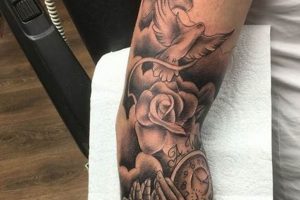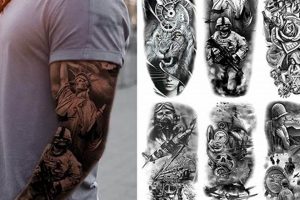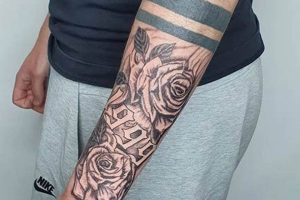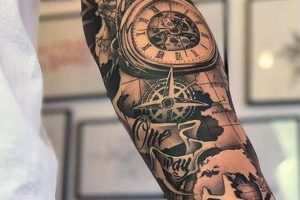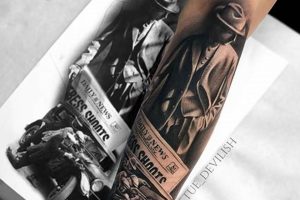A three-quarter sleeve tattoo typically covers the area from just above the elbow to just below the wrist, offering a substantial canvas for artistic expression without fully committing to a full sleeve. This design choice allows for a large, intricate piece while still permitting the option to wear short sleeves without the tattoo being prominently displayed. Examples include nature scenes that flow from upper arm to forearm, mechanical or biomechanical designs showcasing intricate gears and pistons, or portraits interwoven with symbolic elements.
The popularity of this tattoo style stems from its balance of visibility and concealability. It provides ample space for complex designs, enabling artists to create detailed narratives and incorporate diverse elements. This format also allows individuals to express significant aspects of their personality, beliefs, or experiences through visual storytelling. Historically, larger tattoo designs like sleeves have signified group affiliation or served as markers of status within certain cultures. The three-quarter sleeve offers a contemporary adaptation of this tradition, providing a balance between personal expression and societal norms.
This article will delve further into various thematic and stylistic approaches for three-quarter sleeve tattoos, exploring popular motifs, design considerations, and the collaborative process between artist and client.
Tips for Three-Quarter Sleeve Tattoo Designs
Careful planning is essential for a successful three-quarter sleeve tattoo. These tips offer guidance for navigating the design process.
Tip 1: Theme Selection: A cohesive theme unifies diverse elements. Consider themes like nature, mythology, or geometric patterns to create a harmonious design.
Tip 2: Placement and Flow: The natural curves of the arm should be considered. Designs should flow with the body’s contours, enhancing the overall aesthetic.
Tip 3: Artist Collaboration: Open communication with a skilled tattoo artist is crucial. Discuss ideas, explore stylistic options, and ensure artistic vision aligns with personal preferences.
Tip 4: Color Palette: Color choices significantly impact the final result. Consider skin tone and the desired mood when selecting ink colors. Black and grey offer a classic, timeless appeal, while vibrant colors can create a bold statement.
Tip 5: Visual Balance: Distribute visual elements evenly across the arm to avoid overcrowding or imbalance. Negative space can enhance the overall impact of the design.
Tip 6: Planning for Future Additions: If future expansion into a full sleeve is a possibility, plan the initial three-quarter sleeve accordingly. Ensure the design allows for seamless integration of future elements.
Tip 7: Aftercare Research: Proper aftercare is crucial for preserving the vibrancy and longevity of the tattoo. Thoroughly research aftercare practices before the tattoo session.
By considering these factors, individuals can embark on the journey towards a well-executed and personally meaningful three-quarter sleeve tattoo.
These preparatory steps will contribute to a successful and fulfilling tattoo experience.
1. Theme
Thematic coherence is paramount for successful three-quarter sleeve tattoos. A well-defined theme provides a narrative framework, unifying diverse elements into a cohesive and meaningful composition. This thematic foundation guides the selection of imagery, style, and color palette, ensuring the final result resonates with the individual’s vision.
- Nature
Nature-inspired themes offer a wide range of possibilities, from lush forests and cascading waterfalls to celestial bodies and intricate floral patterns. These themes often evoke tranquility, growth, and connection to the natural world. A three-quarter sleeve depicting a forest scene, for instance, could transition from towering trees near the shoulder to delicate wildflowers near the wrist, creating a visual narrative of a journey through nature.
- Cultural Heritage
Tattoos can serve as powerful expressions of cultural identity. Three-quarter sleeves offer ample space to depict cultural symbols, traditional patterns, or mythological figures. Maori T moko designs, for example, can be adapted to the three-quarter sleeve format, showcasing intricate spiral patterns and ancestral narratives specific to the wearer’s lineage. These themes celebrate heritage and personal connection to cultural roots.
- Abstract and Geometric
Abstract and geometric themes provide a platform for artistic exploration and personalized symbolism. Intricate patterns, geometric shapes, and flowing lines can be combined to create visually striking designs. A three-quarter sleeve featuring sacred geometry patterns, for example, can represent balance, harmony, and interconnectedness. These themes offer versatility and allow for highly individualized expression.
- Personal Narrative
Three-quarter sleeves can become visual autobiographies, depicting significant life events, personal beliefs, or cherished memories. These designs often incorporate symbolic imagery that holds personal meaning for the wearer. A sleeve depicting a journey through different landscapes, for instance, could represent the individual’s personal growth and life experiences. These themes allow for deeply personal and meaningful artistic expression.
These examples demonstrate the diverse thematic possibilities within the three-quarter sleeve format. A thoughtfully chosen theme provides a cohesive foundation for the design, ensuring a visually compelling and personally meaningful tattoo. Careful consideration of the chosen theme’s symbolic significance, stylistic representation, and personal resonance ensures a lasting and impactful piece of art.
2. Placement
Placement is a critical factor in the overall impact of a three-quarter sleeve tattoo. The contours of the arm, muscle definition, and joint movement influence how the design flows and appears from various angles. Careful consideration of placement optimizes both the aesthetics of the tattoo and its visual narrative. The placement interacts with the chosen theme and imagery to create a cohesive and dynamic composition. For example, a design featuring a serpent might be strategically placed to wrap around the forearm, emphasizing the natural curvature of the arm and the serpent’s sinuous form. Alternatively, a portrait might be positioned on the outer bicep, creating a focal point that draws the eye.
Practical considerations also influence placement decisions. Individuals with professions requiring more formal attire might opt for placement that allows for easier concealment. The three-quarter sleeve’s inherent flexibility allows for designs that can be partially hidden by short sleeves. Furthermore, placement choices can emphasize or downplay specific elements within the design. Elements intended to be focal points, like a portrait or significant symbol, are often placed on the outer arm for greater visibility. Conversely, less prominent details or background elements might be positioned on the inner arm. The interplay between these factors allows for a nuanced approach to placement, maximizing the overall visual impact and personal significance of the tattoo.
Optimal placement enhances the three-quarter sleeve’s aesthetic appeal, narrative flow, and practical functionality. Understanding the interplay between placement, design elements, and individual preferences is crucial for a successful and satisfying tattoo. Strategic placement choices transform the arm into a dynamic canvas, showcasing the artistry and personal significance of the chosen design.
3. Style
Style significantly impacts the aesthetic and narrative of three-quarter sleeve tattoos. Distinct stylistic choices convey different moods, cultural influences, and artistic interpretations. Selecting a style that aligns with personal preferences and the intended message of the tattoo is crucial for a cohesive and impactful result. For example, realism emphasizes detailed representation, capturing lifelike imagery and intricate textures. A realistic portrayal of a wildlife scene, rendered in meticulous detail, could evoke a sense of reverence for nature. Conversely, a traditional Japanese style, characterized by bold lines, vibrant colors, and iconic imagery like dragons and koi fish, conveys a sense of strength, history, and cultural significance.
Style choices also influence the overall composition and flow of the tattoo. Geometric styles, employing precise lines and symmetrical patterns, can create visually striking and abstract designs. These styles often emphasize balance and harmony, appealing to those drawn to mathematical precision and symbolic representation. The chosen style influences the choice of color palette, line weight, and shading techniques, all of which contribute to the final aesthetic. Understanding the nuances of each style allows for informed decision-making and facilitates effective communication with the tattoo artist. A well-defined style ensures the visual representation aligns with the intended message, creating a cohesive and impactful work of art.
Effective style selection enhances the narrative depth and visual impact of three-quarter sleeve tattoos. Style serves as a visual language, conveying emotion, symbolism, and cultural significance. Whether opting for the intricate detail of realism, the bold lines of traditional styles, or the abstract beauty of geometric patterns, careful consideration of style is essential for a successful and personally meaningful tattoo. This choice bridges the gap between concept and execution, transforming a vision into a tangible piece of art that resonates with individual expression and aesthetic preferences.
4. Color palette
Color palettes play a pivotal role in the overall impact and aesthetic of three-quarter sleeve tattoos. Color choices influence mood, symbolism, and visual cohesion. A well-chosen palette enhances the narrative, complements the chosen style, and ensures the final result aligns with the individual’s vision. The interplay of colors can evoke a range of emotions, from the serenity of cool blues and greens to the passion of fiery reds and oranges. Color selection should consider skin tone, desired level of contrast, and the overall theme of the tattoo. For instance, a black and grey palette can create a classic, timeless aesthetic, emphasizing texture and shading. This approach suits designs focusing on realism or portraiture. Conversely, a vibrant, multi-colored palette can convey energy, joy, and cultural significance. This approach might be favored for designs inspired by nature, traditional Japanese art, or abstract expressionism. Color theory principles, such as complementary or analogous color schemes, can guide effective palette selection.
Practical considerations also influence color choices. Certain colors, particularly lighter shades, may fade more quickly than others, requiring touch-ups over time. Placement on the body can also affect color perception. Areas with more sun exposure may experience faster fading. Collaborating with a skilled tattoo artist is crucial for optimizing color choices. Artists possess expertise in color theory, pigment behavior, and the interplay of colors on different skin tones. They can provide valuable insights and guidance, ensuring the chosen palette achieves the desired aesthetic and longevity. Furthermore, color choices can be used to emphasize specific elements within the design, creating focal points and visual hierarchy.
Careful color palette selection is integral to the success of three-quarter sleeve tattoos. Color evokes emotion, enhances narrative, and contributes significantly to the overall aesthetic. Understanding the interplay of colors, considering practical factors like fading and skin tone, and collaborating with a skilled artist ensures a visually stunning and personally meaningful result. The chosen palette becomes an integral part of the tattoo’s narrative, amplifying its message and ensuring a lasting impact. A thoughtfully chosen palette elevates the tattoo from a visual design to a powerful expression of personal style and artistic vision.
5. Artist Collaboration
Realizing impactful three-quarter sleeve tattoos requires close collaboration between the individual and a skilled tattoo artist. This collaborative process translates personal visions into tangible works of art. Effective communication, shared understanding, and mutual respect between artist and client are essential for achieving a successful outcome. The artist’s expertise guides technical execution, stylistic choices, and placement considerations, ensuring the final result aligns with the individual’s aesthetic preferences and narrative intent.
- Concept Development
Initial consultations form the foundation of collaboration. Clients convey their ideas, inspirations, and desired themes, while artists offer professional insights on feasibility, design elements, and stylistic approaches. Open dialogue ensures a shared understanding of the project’s scope, allowing the artist to translate abstract concepts into concrete visual representations. For example, a client might describe a desired theme of “growth and resilience,” and the artist could suggest incorporating imagery of flourishing plants or symbolic geometric patterns to embody these concepts visually. This initial exchange of ideas sets the stage for a collaborative design process.
- Design Refinement
Collaboration extends beyond the initial concept phase. Artists provide sketches, mock-ups, and digital renderings, allowing clients to visualize the design’s evolution. Feedback from the client informs revisions, ensuring the final design accurately reflects their vision. This iterative process allows for adjustments to composition, color palettes, and individual elements, fostering a sense of shared ownership and ensuring the final tattoo resonates deeply with the client’s personal narrative. For instance, the artist might present different variations of a floral design, exploring color options and placement to achieve optimal visual impact and thematic coherence.
- Technical Expertise and Application
Artists contribute technical expertise in translating designs onto the three-dimensional canvas of the arm. Their understanding of skin types, needle sizes, and ink application techniques ensures the tattoo’s longevity and visual fidelity. Collaboration involves discussing placement strategies, considering muscle contours and joint movement to optimize the design’s flow and visibility. For example, an experienced artist can advise on the best placement for a specific design element to complement the natural curves of the arm and ensure the image maintains its integrity over time. This expertise ensures the final tattoo not only meets the client’s aesthetic expectations but also adheres to best practices for quality and longevity.
- Shared Artistic Vision
Successful collaborations foster a sense of shared artistic vision. Clients and artists engage in a creative dialogue, exchanging ideas and exploring possibilities. This collaborative spirit allows for innovative solutions and unexpected artistic flourishes. The artist’s interpretation of the client’s vision might introduce new perspectives or symbolic elements that enrich the narrative depth of the tattoo. For instance, an artist might suggest incorporating subtle background details or symbolic shading techniques that enhance the overall composition and add layers of meaning to the design. This shared creative exploration elevates the tattoo beyond a mere visual representation to a collaborative work of art.
Artist collaboration is integral to the success of three-quarter sleeve tattoos. This collaborative process ensures the final result reflects not only the individual’s vision but also the artist’s technical expertise and artistic interpretation. Effective communication, iterative feedback, and a shared artistic vision are essential for transforming abstract ideas into compelling and personally meaningful works of art. The collaborative journey enhances the final tattoo, adding layers of depth, symbolism, and artistic expression that resonate with both the client and the artist. This partnership ensures a cohesive and impactful result, a testament to the power of shared creativity and technical mastery.
Frequently Asked Questions
This section addresses common inquiries regarding three-quarter sleeve tattoos, offering clarity on practical considerations and design choices.
Question 1: How long does a three-quarter sleeve typically take to complete?
Completion time varies based on design complexity, size, and individual pain tolerance. Multiple sessions, often spaced weeks apart for healing, are generally required. A typical timeframe ranges from 10 to 20 hours in total.
Question 2: What factors influence the cost?
Cost depends on artist experience, hourly rates, design intricacy, and color usage. Obtaining quotes from multiple reputable artists is recommended.
Question 3: How painful is the process?
Pain levels vary depending on individual pain thresholds and the specific location on the arm. The inner arm and areas near joints are often reported as more sensitive. Consultations with artists can address pain management strategies.
Question 4: Can existing tattoos be incorporated into a three-quarter sleeve?
Incorporation is often possible. Skilled artists can integrate existing tattoos into new designs, creating a cohesive overall composition. Consultations are essential for assessing feasibility and design options.
Question 5: What is the healing process like?
Proper aftercare is crucial for optimal healing and color retention. Following artist instructions regarding cleaning, moisturizing, and sun protection is essential. Healing typically takes several weeks.
Question 6: How can one choose the right tattoo artist?
Researching artist portfolios, reviewing client testimonials, and scheduling consultations are essential steps. Choosing an artist specializing in the desired style ensures a successful outcome. Verify licensing and adherence to hygiene standards.
Thorough research and open communication with experienced artists are crucial for navigating the process of acquiring a three-quarter sleeve tattoo. These proactive steps contribute to a successful and satisfying experience.
For further inquiries, consult with reputable tattoo artists specializing in three-quarter sleeve designs.
Conclusion
Three-quarter sleeve tattoos offer a compelling canvas for personal expression, enabling individuals to showcase intricate narratives and artistic visions. Careful consideration of thematic coherence, strategic placement, stylistic choices, and color palettes ensures a cohesive and impactful result. Collaboration with skilled artists translates personal concepts into technically proficient and aesthetically pleasing tattoos. Addressing practical considerations, such as cost, pain management, and aftercare, ensures a positive and informed experience.
The three-quarter sleeve format provides a significant yet adaptable platform for self-expression. Thoughtful planning and collaboration with experienced professionals transform this canvas into a powerful medium for storytelling, artistic exploration, and personal commemoration. This approach ensures a lasting piece of art that resonates with individual identity and aesthetic preferences.



